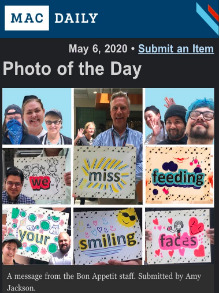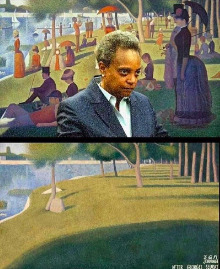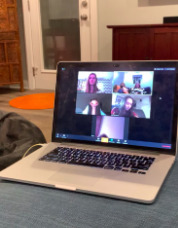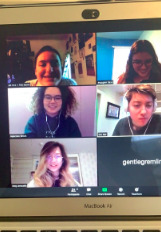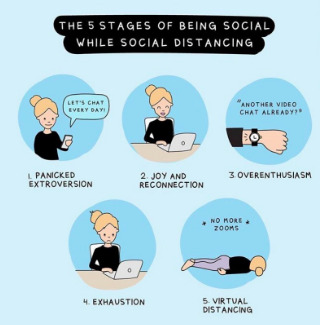Digital Connections in a Time of Physical Isolation
Sivali Bhandary, Ama Kyereme, Maura Haas
1. Social Connectedness Despite Physical Distance
A big challenge that we face as a result of the pandemic lockdown is the disconnectedness from society. Being the social animals that we are, humans are struggling to go on with their daily lives without physical social interactions. But thanks to social media and different online platforms; we have still managed to stay in touch with our loved ones and wider communities. As Professor Carter mentioned, it is indeed ironic how communication with someone thousands of miles away feels no different than communication with someone just two minutes away.
At these times, we have learnt to appreciate the existence of social media more than ever.
We have become reliant on it to not only keep the social animals in us sane but also to stay connected to honor family traditions.
“We had a group facetime call with my mom’s side of the family for a while this afternoon catching up and pretending like we were together like we normally are on Easter.” -Lauren Whyte
Even on regular occasions, we are finding ourselves on Zoom calls and group facetimes with our family and friend groups. We have learnt to value human friendships and relationships like never before. Physical barriers are breaking down and allowing us to feel the presence of our loved ones through a computer/phone screen. For those of us who are miles away from home, social media is helping beat nostalgia and allowing us to feel more close to home.
“I talk often to my parents, grandparents, and friends in Nepal, cousins in the US, and friends from Macalester. I also recently FaceTimed my highschool friends and we reminisced about our highschool years. I felt genuine joy laughing with these people even though it was through a screen. The world feels so small when I’m on my phone.” -Sivali Bhandary
Online social interactions are not only limited to families and close friends but also wider communities. The internet has played the powerful role of bringing a semblance of togetherness in the Macalester community amidst the crazy pandemic. MacDaily posted an image of the The Bon Appetit staff sending out the sweetest message: “We miss feeding your smiling faces.” These digital social interactions are friendly reminders that WE ARE NOT ALONE!
Different Macalester departments/student organizations have also made online adjustments to replicate the overall college experience on digital platforms. Indeed, a big shout out to the Macalester Program Board for pulling off an amazing virtual spring fest! Macalester also has a grand digital commencement planned to celebrate the achievements of Class of 2020.
“Today I went to Springfest virtually, and it was such an interesting experience. The artists were performing from their homes thousands of miles away, but through Zoom, I was able to chat with them and my friends from Mac.” -Ama Kyereme, April 18, 2020.
Similarly, some students are taking it upon themselves to re-create the college experience online.
“From Thursday to Sunday, almost every night, we party hard over Zoom.” -Anonymous, May 4, 2020
Many of us are also using digital connections as a way to check up on the vulnerable members of our families and communities. We are constantly reminding them of the precautions they should be taking and distance caring for them. Some of us are also teaching them how to use these technologies better. Lot of us are getting strength to fight another day through social interactions with our loved ones.
“I am grateful that I have access to the internet and have a phone to keep in touch with my family. I couldn’t imagine how depressed I would have been if I didn’t have people I could connect with online.” -Nita Senesathith, April 8, 2020
Through digital connections, we can lend emotional support to our loved ones, keep each other entertained with good company, and be there to help each get through hard times. We are indeed blessed to have access to these amazing technologies. Now, more than ever, it is important to stay connected with those around us, even if those interactions must happen in a new space.
2. Internet Usage
With a lot of free time in our hands, we have found ourselves spending a lot of time on the internet these days. Social interactions are beginning to look different as the contexts in which we can interact are changing. Online platforms, like Zoom, Netflix, Instagram, Facebook, TikTok, etc. are the new leisure spaces during the coronavirus pandemic. Television programs, live events, and family gatherings are all moving online, potentially bringing in more participants and more connectedness. Many of us are relying on content on these platforms to keep us entertained.
“American Idol announced that the show is going to continue and that contestants will be singing from home and judges will be judging from home.” -Sivali Bhandary, April 14, 2020
Netflix binge-watching and speed scrolling on Instagram have become few of our favorite hobbies. The internet is currently obsessed with shows like “Tiger King” and “Outer Banks” and there is a whole wave of creative energy on TikTok that we can’t seem to get enough of.
In the face of this pandemic, online platforms and trends have helped unify people. Cities are banding together via memes and broader social media, sharing images and jokes that may only be relevant to their home.
“In times of pandemic like this, social media has allowed us to see the amazing solidarity in these communities globally.” -Nita Senesathith, April 3, 2020.
For example, the mayor of Chicago, Lori Lightfoot, has become a quasi-Where’s Waldo meme. People are photoshopping her into images as a way to push social distancing and other mitigating measures (see meme of Lightfoot in the painting “A Sunday Afternoon on the Island of La Grande Jatte,” which is displayed in the Art Institute of Chicago). Memes are sometimes used as a coping mechanism for dealing with these tough times as well. TikTok, an app where users post short videos, is home to many instances of dark humor about the coronavirus pandemic. Teenagers often find comfort in joking about their struggles, sharing and laughing about their experiences together.
“Despite the dark humor, I think memes are a brighter point for many people. In a way, they connect and bring people together under one inside joke.” -Maura Haas, April 3, 2020
However, not all of the interactions happening online are positive. Many of us are often getting overwhelmed by the amount of new content circulating in our social media feeds. We feel exhaustion as a result of the overuse of these social media apps.
“I do spend a lot of time doing absolutely nothing on my phone and I’m probably depriving myself of the inspiration and knowledge that I could derive from reading. Can spending too much time on the internet dumb you down?” -Sivali Bhandary, April 1, 2020
We are also having a hard time focusing on school because of all these distractions. Some of us have even started keeping tabs on our phone and television usage.
“I have been rationing my TV time because I am getting sick of watching shows. I can’t seem to focus on a show long enough.” -Lauren Whyte
A lot of people are resorting to the internet to stay updated on coronavirus case numbers in their localities and around the world. Though this has been helpful in spreading accurate information, the obsessive checking of news and numbers sometimes leads to exacerbated anxieties about the situation. There also is a high chance of running into misinformation and rumors about the coronavirus, which is creating a lot of panic and confusion around the pandemic.
"I think that the one of the scariest things about the virus is the mass amounts of information being communicated to the public, and most of the public (including myself) do not really know what to make of everything." -Maura Haas, April 2, 2020
There are a large amount of inspiring survival stories being shared on the internet. Many people are honoring frontline workers who have been risking their own lives to save millions. There are positive messages on Instagram reminding people to stay strong and be there for each other. The internet has come together as a uniting force. Nevertheless, there also is a large amount of negative energy on social media feeds.
“In this article, she talks about how this stigmatization she faced as a corona patient through hate comments on social media, emotionally and mentally challenged her wellbeing.” -Sivali Bhandary, April 19, 2020
Thus, online platforms have helped many of us cope with the storm and stress of the pandemic. Nevertheless, there is a thin line between how much good and bad it can do.
3. Rising Technologies Will Stick Around
Zoom, Netflix Party, GrubHub, TikTok.
These platforms existed before the coronavirus pandemic, but they have risen to mass popularity in recent weeks. These technologies have helped make quarantine bearable by keeping the world connected, mimicking daily activities like conversing with friends and eating nice meals. With many businesses able to shift to online operations and ordering services, people are finding it easier to access what they would like. While they are not perfect substitutes, these rising technologies have become important parts of our lives during this pandemic, and they likely will remain that way moving forward.
“Having something so simple, positive, and light-hearted to connect over is really refreshing. I can see Tik-Tok having a lasting impact on this internet generation like Vine had a couple years ago.” -Ama Kyereme, April 25, 2020
One thing we have noticed about our own social lives during quarantine is that we feel even more connected to friends and family. As touched on in the section “Social Connectedness Despite Physical Distance,” people are using online platforms to communicate and, as a result, they are interacting more with people because it is easier to do so. The need for physical space had already been diminishing before quarantine, but the last few months have proved that physicality is not necessary. Perhaps this will become a negative, though, as proper face-to-face interactions are replaced with Zoom calls and Snapchats. As we increasingly rely on online platforms to communicate, we may remain physically isolated from each other. There are pros and cons to these technologies, and we hope that we can find a way to balance the two so that we can maintain meaningful social connections.
“Strangely, I feel like I talk more to my family during this time... Perhaps this is because we are more aware of the technology that can help us communicate, so we use it more often.” -Maura Haas, April 5, 2020
Many are enjoying this increase in connection. The newfound popularity of Zoom, in particular, will probably last. Conferencing services like Zoom allow for remote work and learning to take place. The ability to talk in real time with people that may be distant could continue to be useful in classroom and work contexts.
“I’ve recently discovered a love of seeing my friends and their families on social media,” -Rebecca Driker-Ohren
“In some ways, I feel more connected to friends and family than ever because of it, and I do not want that to go away.” -Maura Haas, April 12, 2020
4. Online Classrooms Are Not the Same
As a result of the coronavirus pandemic and several state-issued stay-at-home orders, schools all over the United States made the decision to transfer to remote learning. As a result of this video conferencing platforms like Zoom became the primary communication tool in online classrooms. Students have had to adapt this sudden change in the educational system, and many have found this transition to be difficult. Students are expressing difficulty adjusting to remote learning all over social media. Through the use of memes, many are communicating the negative impacts they have had on their mental health. Financial insecurity and a lack of structure due to remote learning are some of the subjects many memes are based on. It is undeniable that online classrooms are nothing like in person classrooms, and that has had a great impact on students in terms of their learning as well as their mental health and social interactions.
“It's been sort of awkward trying to navigate online classes. For some reason, Zoom classes make me feel super tired. I think they call it Zoom Fatigue.” -Ama Kyereme, April 27, 2020
“In lecture classes, I never get the chance to see everyone’s face, nor do I get to see people who laugh at the same things, or whose bedrooms look just like mine. My eyes and head hurt at the end of the day, but I am glad to be interacting with classmates, whatever form that takes” -Rebecca Driker-Ohren
Remote learning also poses a challenge in terms of accessibility. In order for students to successfully participate in online classes, they have to have a reliable internet connection and a device with webcam capabilities that assignments can be done on. Some schools have tried to provide support to students in order to address the gaps in access through the use of alternative grading options, but the switch to remote learning has continued to reveal the lack of equity within the education system.
“Chicago Public Schools (CPS) serves a lot of disadvantaged, vulnerable kids who do not have access to the same resources that their peers have. In a time when distance learning must take place, computers are one resource that are almost necessary.” -Maura Haas, April 8, 2020
Overall, for both students and educators, there is a shared desire to return to traditional learning as soon as possible. Macalester College is one institution that has expressed a preference for reopening the school for the Fall 2020 semester if permitted by the Minnesota Department of Health.
“There is a lot of unpredictability about what is to happen next year but I’m hoping we can still go back to school for the Fall. That’s the thing about corona: people keep saying I hope things go back to normal, but what is normal even gonna look like?” -Sivali Bhandary, April 16, 2020

